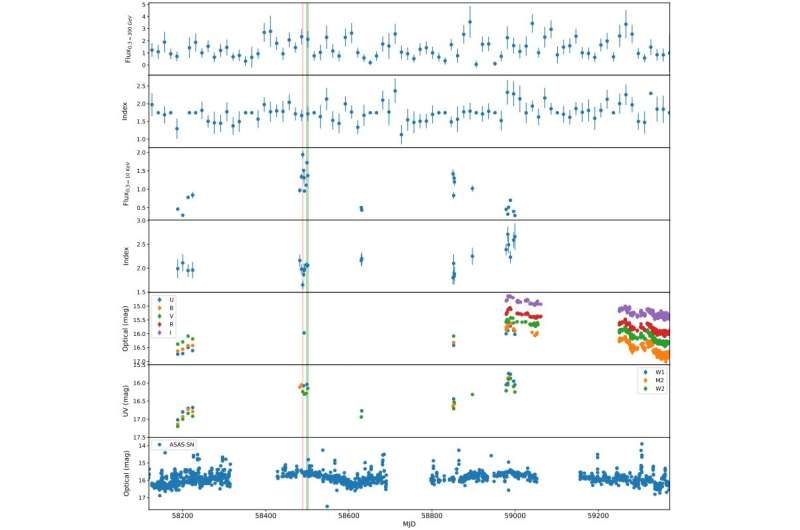January 11, 2023 report
This article has been reviewed according to Science X's editorial process and policies. Editors have highlighted the following attributes while ensuring the content's credibility:
fact-checked
preprint
trusted source
proofread
Blazar 1ES 1218+304 inspected in detail

An international team of astronomers has performed a comprehensive, multiwavelength study of a blazar known as 1ES 1218+304. Results of the research, presented in a paper published January 3 on the arXiv preprint server, provide more insights into broadband properties of this source.
Blazars, classified as members of a larger group of active galaxies that host active galactic nuclei (AGN), are the most numerous extragalactic gamma-ray sources. Their characteristic features are relativistic jets pointed almost exactly toward the Earth. Based on their optical emission properties, astronomers divide blazars into two classes: flat-spectrum radio quasars (FSRQs) that feature prominent and broad optical emission lines, and BL Lacertae objects (BL Lacs), which do not.
Some blazars are high synchrotron peaked (HSP) sources as their synchrotron peak is above 1,000 THz in the rest frame. Observations show that particles are efficiently accelerated up to very high energies (VHEs) in the jets of HSPs, which makes such sources very interesting for astronomers studying extreme blazars.
At a redshift of 0.182, 1ES 1218+304 is a HSP BL Lac detected in 2003 and first observed in VHEs in 2006 with the Major Atmospheric Gamma-ray Imaging Cherenkov Telescope (MAGIC). It exhibits a hard gamma-ray spectrum from MeV/GeV to TeV band, suggesting that the emission is most likely produced from fresh accelerated electrons.
A group of astronomers led by Rishank Diwan of the University of Hong Kong conducted multiwavelength observations of 1ES 1218+304, hoping to shed more light on its properties. For this purpose they used various spacecraft and ground-based observatories, such as NASA's Fermi Gamma-ray Space Telescope and Neil Gehrels Swift Observatory, India's AstroSat, the 0.6m RC robotic (T60) and the 1.0m RC (T100) telescopes at TUBITAK National Observatory, and also the 0.5m RC telescope at Ataturk University in Turkey.
The observations were carried out between January 2018 and March 2021. The collected data allowed the researchers to explore the broadband temporal and spectral behavior of 1ES 1218+304 during its flaring states.
The astronomers detected a high-flux event in VHE gamma-rays from 1ES 1218+304 in January 2019. The fast flux variability in gamma-rays was calculated to be approximately 0.275 days and the size of the emission region was estimated to be about 80 billion kilometers.
The study found that 1ES 1218+304 showcases the so-called "harder-when-brighter" trend in X-rays, while a "softer-when-brighter" trend was observed in gamma-rays. It was noted that the gamma-ray emission from this blazar can be described by a power law with a spectral index of about 1.745.
Based on the data from AstroSat, a minute scale of variability was identified of the order of 20 minutes and the X-ray spectrum turns out to be well fitted with both power-law and the log parabola models. AstroSat results also allowed the researchers to put constraints on the synchrotron peak roughly, which is estimated to be around 268 PHz. In addition, a shift in synchrotron peak was observed from one state to another state from about 100 to 100,000 PHz, which suggests an extreme nature of 1ES 1218+304.
More information: Rishank Diwan et al, Multi-wavelength study of TeV blazar 1ES 1218+304 using gamma-ray, X-ray and optical observations, arXiv (2023). DOI: 10.48550/arxiv.2301.00991
Journal information: arXiv
© 2023 Science X Network




















